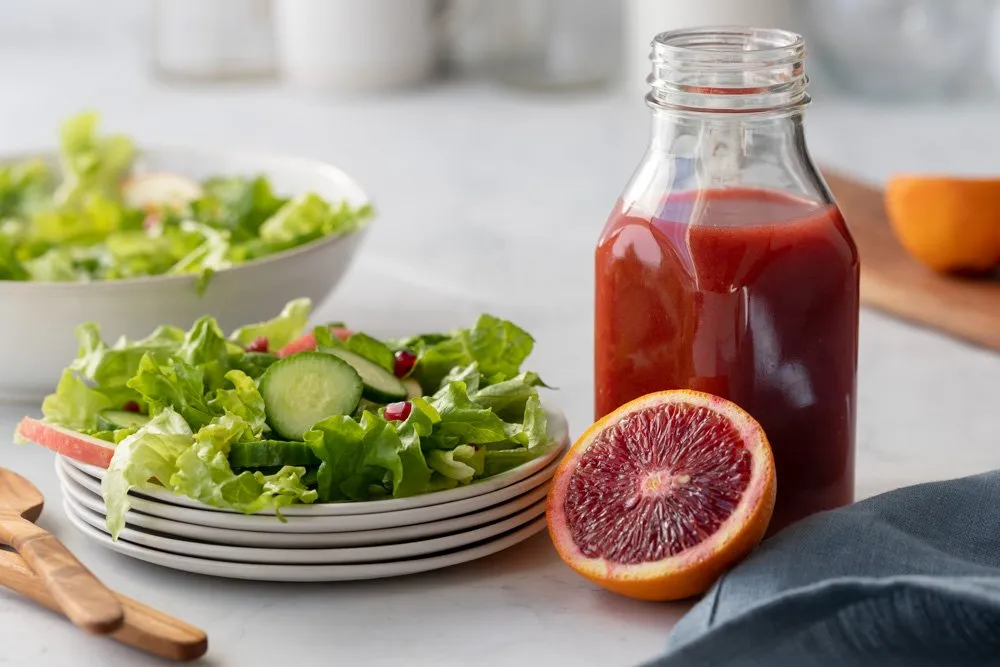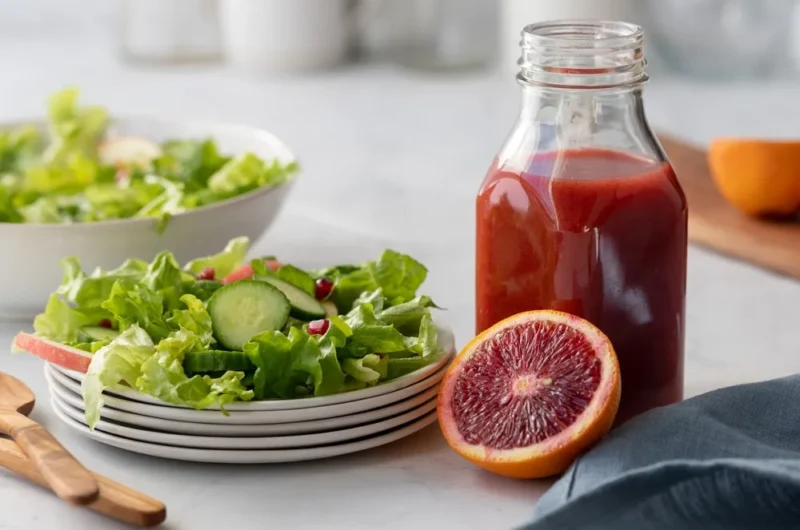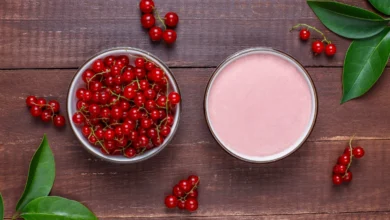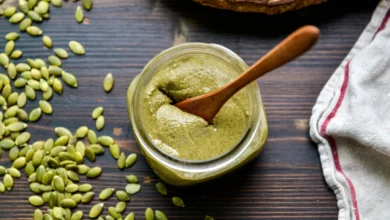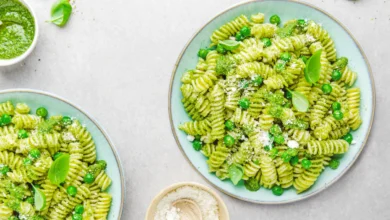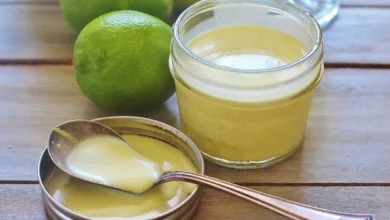Blood Orange Vinaigrette: 5-Minutes Recipe
Blood oranges offer a whole new dimension to the classic vinaigrette. Their stunning crimson flesh isn’t just eye-catching; the anthocyanins responsible for that deep color are also potent antioxidants. These unique citrus fruits bring a delightful balance of tart and juicy to the dressing.
Contents
- Blood Orange Vinaigrette
- Blood Orange Vinaigrette Recipe
- Ingredients
- Directions
- Notes
- Nutritional Information (per serving)
- Health Benefits
- Frequently Asked Questions
- What is vinaigrette dressing made of?
- What does blood orange taste like?
- What would you use blood orange olive oil for?
- Why is it called vinaigrette?
- What is the formula for vinaigrette dressing?
- What is the difference between vinaigrette and vinegar?
- Is blood orange a grapefruit?
- Can I make blood orange dressing ahead of time?
- How to store blood orange salad dressing?
- Can I freeze it?
Blood Orange Vinaigrette
This vibrant Blood Orange Vinaigrette is a zesty and refreshing twist on the classic dressing, perfect for brightening up winter salads. Let’s make it!
Choosing Your Blood Oranges
There are a variety of blood oranges to experiment with. Some have a red blush on the rind, while others look like regular navel oranges on the outside. The real surprise is inside! Look for ones that feel heavy for their size – that means they’re full of flavorful juice.
Personal Touch: I always pick a few extra blood oranges. Their gorgeous slices are perfect for garnishing salads or adding a splash of color to desserts.
Why You’ll Love This Recipe
Here’s why this Blood Orange Vinaigrette is about to become a favorite:
- Seasonal Delight: Blood oranges are at their peak during the winter months. Their sweetness and subtle raspberry notes are a welcome brightness in salads during the colder seasons. Think of it as edible sunshine!
- Flavor Dynamics: Blood oranges have a nuanced flavor that’s both sweeter and less acidic than regular navel oranges. This creates a dressing that’s vibrant yet balanced.
- Clean and Versatile: This recipe celebrates whole foods with simple ingredients you likely already have or can easily find at grocery stores or farmer’s markets. The vinaigrette itself is incredibly versatile:
- Perfect for savory salads.
- Adds zing to fruit salads.
- Use it as a marinade for chicken or fish
- Try it in a massaged kale salad for a flavor explosion!
Equipment
Making salad dressings and vinaigrettes is incredibly simple, and you likely have everything you need on hand. A classic mason jar with a tight-fitting lid does the trick. Just add your ingredients, seal, and shake until everything is beautifully combined! However, sometimes a whisk and mixing bowl are more convenient, especially if you’re making a larger batch.
If you make dressings frequently, a dedicated salad dressing shaker like the Oxo Good Grips model is a worthwhile addition to your kitchen. They typically have convenient measuring marks and a drip-free spout for easy pouring.
Serving Suggestions
This vibrant blood orange dressing pairs beautifully with a variety of ingredients. Here’s one delicious idea to get you started:
- Create a simple spinach salad with a handful of fresh blueberries. The sweetness of the berries plays perfectly against the tart dressing.
- Crumble creamy blue cheese or tangy goat cheese on top for extra richness.
- Add toasted pistachios for a satisfying crunch.
- Garnish with a few thin slices of blood orange for a touch of elegance.
READ: Blood Orange Yogurt Cake
How Should I Store This Vinaigrette?
This Blood Orange Vinaigrette will keep well in the refrigerator for up to a week. Store it in an airtight container, such as a mason jar or a repurposed dressing bottle. Due to natural separation of the ingredients, give it a vigorous shake before each serving.
Tip: If the dressing has been chilled for a while, let it sit at room temperature for a few minutes before using. This will allow the olive oil to become more fluid again, making it easier to mix.
Blood Orange Vinaigrette Recipe
Course: AppetizersCuisine: Mediterranean1
cup of vinaigrette5
minutes144
kcalThis vibrant Blood Orange Vinaigrette is a zesty and refreshing twist on the classic dressing, perfect for brightening up winter salads. It takes just minutes to prepare!
Ingredients
½ cup extra-virgin olive oil: The richness of a good olive oil is essential to a balanced vinaigrette.
⅓ cup freshly squeezed blood orange juice: Around 2 or 3 blood oranges will usually provide this amount.
¼ cup red wine vinegar: Adds a slightly acidic tang to the dressing.
2 tablespoons honey: This sweetener complements the citrus notes beautifully.
1 tablespoon spicy brown mustard: Provides a touch of heat and complexity.
Salt and freshly ground black pepper to taste: For seasoning and bringing all the flavors together.
Directions
- Gather Ingredients: Prepare your olive oil, blood orange juice, red wine vinegar, honey, mustard, salt, and pepper.
- Combine in a Blender: Add all ingredients to a blender.
- Process Until Smooth: Blend until well combined and the mixture has a smooth consistency.
Notes
- If you don’t have a blender, you can vigorously whisk everything together in a bowl or shake in a sealed jar.
- Adjust Sweetness: If you find the vinaigrette too tart, add a touch more honey or a pinch of sugar to balance the flavors.
- Make it Spicy: For a little kick, add a pinch of red pepper flakes or some finely chopped jalapeno.
- Herb Variations: Swap out the flavors by using fresh herbs like basil, thyme, or rosemary.
- Storage: The vinaigrette will keep in the refrigerator for up to a week in a sealed container. Shake vigorously before using.
- This recipe yields approximately 1 cup of vinaigrette. A standard serving of salad dressing is 2 tablespoons, but feel free to adjust the portion to your liking.
Nutritional Information (per serving)
| Nutrition Facts | Amount |
| Calories | 144 |
| Fat | 14g |
| Carbs | 6g |
| Protein | 0g |
READ: Dehydrated Orange Slices
Health Benefits
While this Blood Orange Vinaigrette should be enjoyed in moderation as part of a balanced diet, its ingredients offer some potential health benefits:
- Blood Oranges: These are a rich source of antioxidants, particularly anthocyanins, which may help protect cells from damage and reduce inflammation. They’re also an excellent source of vitamin C, important for immune function.
- Olive Oil: A staple of the heart-healthy Mediterranean diet, olive oil is rich in monounsaturated fats, which can help lower “bad” cholesterol levels and support cardiovascular health.
- Honey: While a natural sweetener, honey in its raw form contains trace amounts of vitamins, minerals, and antioxidants.
- Red Wine Vinegar: May offer some digestive benefits and contains polyphenols which have antioxidant properties.
Important Note: Remember, the overall healthfulness of this vinaigrette depends on how much you use and the rest of your diet.
READ: How to Make Whipped Honey
Conclusion
Blood Orange Vinaigrette is a delightful way to celebrate the unique flavors of this seasonal citrus fruit. Its versatility makes it a fantastic addition to your recipe repertoire. Let the sweet, tart, and slightly floral notes of blood orange elevate your salads, transform simple grilled proteins, and add a burst of sunshine to your meals all winter long!
_____________________________
Frequently Asked Questions
What is vinaigrette dressing made of?
At its core, a vinaigrette is a blend of oil, vinegar, and seasonings to create a flavorful emulsion. Salt, pepper, herbs, shallots, mustard, and even cooked vegetables or grains can be added for extra depth and complexity.
What does blood orange taste like?
Blood oranges have a complex flavor that’s similar to navel oranges, but with a hint of floral sweetness and a bit more tartness. Many people find them sweeter, less acidic, and with a subtle raspberry-like taste.
What would you use blood orange olive oil for?
Blood orange olive oil is incredibly versatile! Try it in baking (cakes and brownies), for drizzling over fish, chicken, or rice, or as an essential part of dressings for salads with fresh fruit and nuts. It’s also delicious drizzled over seafood dishes.
Why is it called vinaigrette?
The word “vinaigrette” comes from the French word “vinaigre,” meaning vinegar. Traditional French vinaigrette was very simple – often just olive oil, aromatic vinegar (like wine vinegar), and sometimes lemon juice.
What is the formula for vinaigrette dressing?
The classic French ratio for vinaigrette is 3 parts oil to 1 part vinegar. However, you can adjust it to your liking for a less oily or more tangy taste. Remember, the best way to make your dressing is to put all the ingredients in a small container, add a pinch of salt, shake well, and taste to adjust the flavors.
What is the difference between vinaigrette and vinegar?
Vinaigrette is a type of salad dressing that uses vinegar as a key ingredient. Think of balsamic vinaigrette: it contains oil, balsamic vinegar, often a bit of sugar and mustard, and seasonings like garlic, salt, and pepper. It’s a much healthier option than store-bought salad dressings.
Is blood orange a grapefruit?
While both blood oranges and grapefruits are citrus fruits and share some similarities, they are distinct varieties with their own unique characteristics and flavors. Blood oranges belong to the Citrus sinensis species and are known for their deep red, almost maroon-colored flesh.
Can I make blood orange dressing ahead of time?
Absolutely! You can make this dressing a few days ahead of time. Just give it a good shake before serving to address any natural separation.
How to store blood orange salad dressing?
Store your blood orange dressing in an airtight container in the refrigerator. It should last for up to two weeks. Before using, allow it to come to room temperature and give it a good shake.
Can I freeze it?
Freezing vinaigrette isn’t generally recommended. Freezing and thawing can cause the ingredients to separate, and the flavors might become muted. If you must freeze, consider dividing the blood orange dressing into ice cube molds. This allows you to quickly thaw individual servings as needed.

